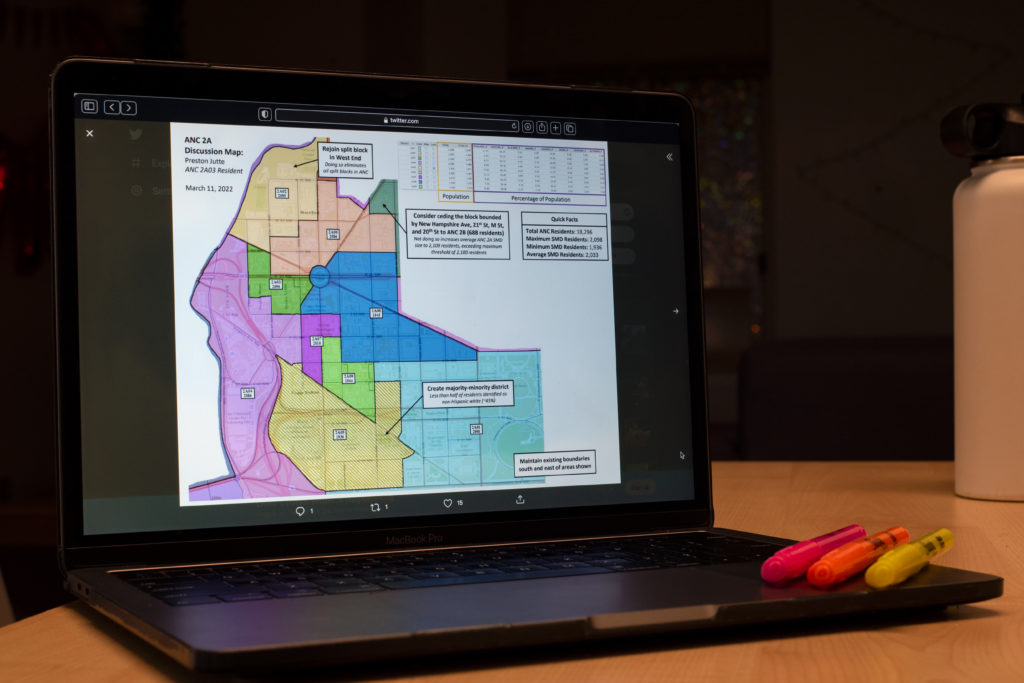Foggy Bottom community members say students may lose representation on a local governing body in the next decade as part of an upcoming citywide redistricting process.
Every 10 years after each census, the D.C. government redraws the lines of its advisory neighborhood commissions, locally elected boards that make recommendations to city officials. A 14-member task force is weighing two Foggy Bottom maps – both of which contain nine single-member districts, an increase from the current eight SMDs – and community members say the number of student-filled districts could decide the level of representation students and people of color on the local ANC.
One map, dubbed the “Unity Map” – submitted by former ANC chair James Harnett, current ANC chair Joel Causey and Foggy Bottom resident Preston Jutte – would contain the first ANC district composed of a majority of people of color in Foggy Bottom’s history with the Columbia Plaza Apartments and The Statesman building.
“It would be the only SMD where only 45 percent of the population of the people in that single-member district would identify as non-Hispanic white, which would be certainly a first for our community,” Harnett said during one of the task force’s meetings.
Harnett said his map distributes the votes of students in residence halls across four SMDs, as opposed to other maps that consolidates student votes into a single district in an effort to minimize students’ say on ANC matters. Junior Margaret McDonald currently represents the only SMD primarily made of students, which includes District and Potomac houses, South, Guthridge, Lafayette and Strong halls, Greek life townhouses and the F Street House.
“We’re not seeing any districts where 100 percent of the population are students in order to devalue their votes and – I can’t remember the technical term for it – but make sure that their votes aren’t able to count in other districts,” Harnett said during the meeting. “It does a very good job of integrating people into the neighborhood.”
Some community members are divided over whether to cede Hamilton House – an apartment building on New Hampshire Avenue with nearly 700 residents between Washington and Dupont circles – to Dupont Circle’s ANC instead of the Foggy Bottom and West End ANC. Harnett said Hamilton House should leave the Foggy Bottom ANC, arguing the average population for single-member districts will jump above the 2,100 population limit set by the D.C. Council if it stays.
He said Hamilton House should be in Dupont Circle’s ANC because the residents of the building said they feel like they live closer to and are more involved with the affairs of Dupont Circle, instead of Foggy Bottom.
“When you’ve got a building where you walk out the front door and you look to your right and you can see Dupont Circle, I don’t know that it would be a good idea that the Foggy Bottom and West End ANC would have jurisdiction over that,” Harnett said. “I mean, it advertises itself as a Dupont Circle building.”
The other map under task force consideration was submitted by West End Citizens Association Secretary Barbara Kahlow and keeps Hamilton House within the boundaries of Foggy Bottom’s ANC, exceeding the 2,100 person-per-district limits. Kahlow said her map aims to preserve the Foggy Bottom Historic District, a neighborhood of historic houses west of campus, in a single district.
“The Foggy Bottom Historic District is probably the most important thing to most people who live in Foggy Bottom,” Kahlow said in a task force meeting. “The alternative map has a separation of the two main squares – it would destroy the preservation of the historic district.”
Kahlow did not immediately return a request for comment.
Trupti Patel, an ANC commissioner, said Kahlow’s map splits sparse student populations between several districts as the minority with less sway in SMDs. The Unity Map splits residence halls across four different SMDs while Kahlow’s map splits residence halls through six separate districts.
“They’re spread out amongst the different single member districts, but they’re spread out in a way where they’re consistently the minority in those single member districts,” Patel said. “And there has been a deliberate attempt to do that.”
The Ward 2 ANC redistricting task force has met 10 times and will meet to finalize their recommendations to the Council in two meetings this month, according to its website. D.C. Council hearings on ANC borders will start in April, where students and residents can provide public testimony, and the Council will vote on the maps in June, according to at-large Council member Elissa Silverman’s website.
Patel said students should testify to the D.C. Council when city lawmakers start hearings on ANC maps in April.
“You need to get engaged,” Patel said in an interview. “You can’t sit here and talk about being a student in the nation’s capitol and fighting to make sure that people’s right to vote aren’t eroded if your very own right to representation is being diluted.”








